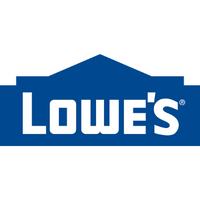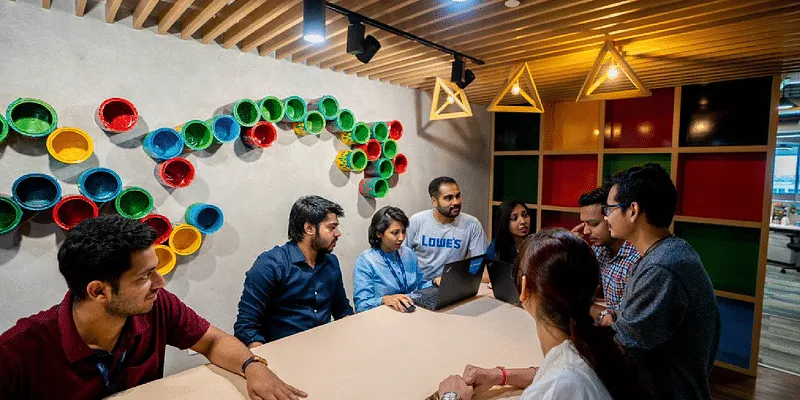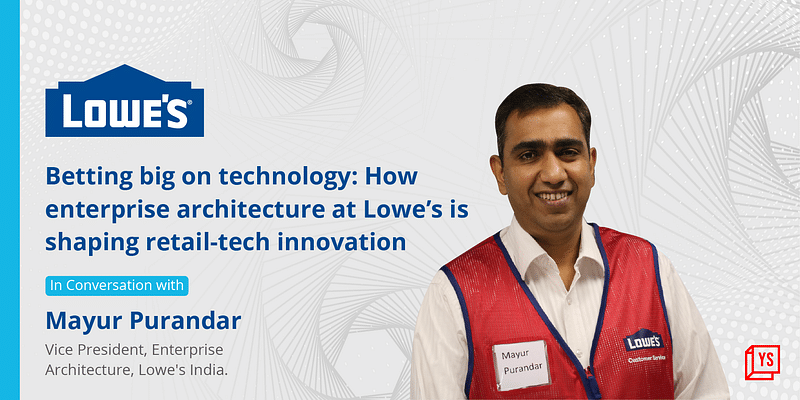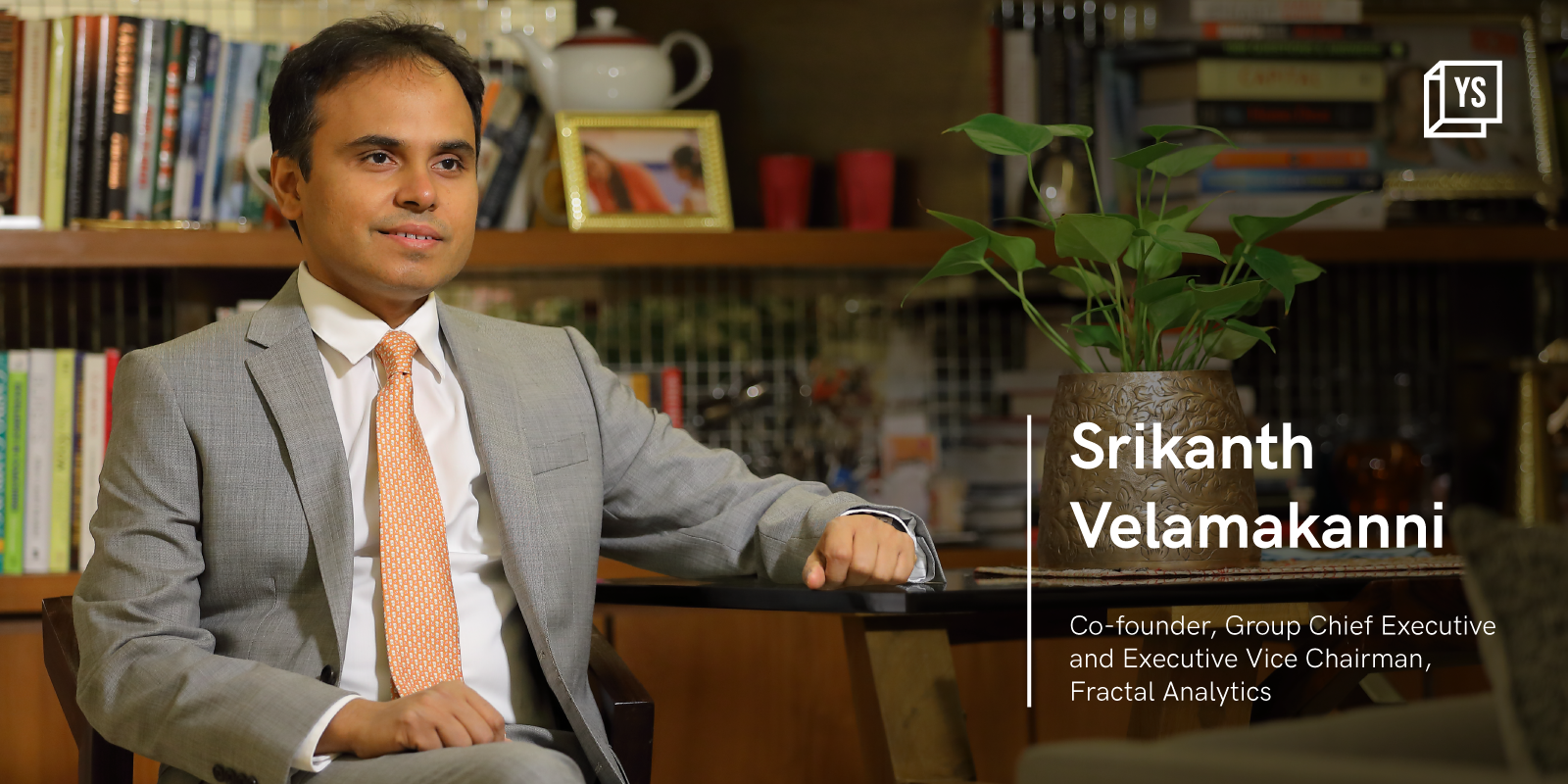
Lowe’s India
View Brand PublisherBetting big on technology: How enterprise architecture at Lowe’s is shaping retail-tech innovation
In a chat with YourStory, Mayur Purandar, Vice President, Enterprise Architecture, Lowe's India, sheds light on the home improvement retailer’s tech modernisation process, how the team grew amid the pandemic, and how the team is tapping new-age technologies.
At Lowe’s India, the Enterprise Architecture team forms the bedrock of all technology innovation. Led by Mayur Purandar, Vice President, Enterprise Architecture, the team has played a key role in reshaping the retail architecture within to become a world-class, customer-centric, omnichannel retailer.
We spoke to Mayur Purandar to discuss the role of the team in-depth, understand how Lowe’s India leverages new-age technology.
Edited excerpts from the interview:
YourStory (YS): What is the secret behind building a technology architecture that drives and enables seamless tech innovation for a retail business that is as large scale as Lowe’s? How challenging is this feat?
Mayur Purandar (MP): Enterprise architecture provides a company with structure while it undergoes transformation. We peel off the layers of old legacy systems in a very structured and systematic way. Our team provides that scaffolding for all technology teams to start working on that transformation journey. How do we do this? Our architects not only specialise in varied technology domains but are also focused on retail fundamentals. This enables the technology stack to reflect retail fundamentals, not organisation structures. While business teams can have stores business team, an online business team, or a supply chain business team and so on, our technology - or the way we build architecture - should not be reflected in that. The architecture we build and modernise is independent of channels of communication- it is homogenised across channels and that’s what makes us truly omnichannel by default.
Being a home improvement retailer, Lowe’s has a really complex business model. Our customer interactions start way before they log on to the website or go to a store because they are looking for inspiration. We go offline, connect with them ahead of their purchase to inspire them, and provide information for their re-modelling projects, big-ticket buys etc. We have to handhold them through the purchasing journey through idea to inspiration to complex installation processes and even post-installation. This is why our architecture and architects work together to come across as one retailer for all our customer touchpoints.
YS: The pandemic made many companies, irrespective of size, scale with the help of technology. What impact did technology have at Lowe’s during those years?
MP: The pandemic was indeed a really challenging phase for those without solid tech architectures but thankfully at Lowe’s, we were already on our modernisation journey- the pandemic only fast tracked it. People started spending more time at homes and we saw an exponential increase of orders on our website. Our dotcom site was already on microservices architecture using a public cloud so our ability to scale up became really important.
Secondly, people weren't getting into stores, so we had to build a lot of tech online, to help people figure out how to do home improvement. Omnichannel became critical from a customer shopping behaviour perspective. Even if people went back to stores, they had seen the convenience of shopping online, and wanted this blend to come across seamlessly. We made multiple upgrades to our systems at that time, and we continue on our journey till date and the pandemic taught us that tech debt is not an option. We are making a lot of investments to really build our omnichannel tech ecosystem and a lot of the exciting work is happening out of our Bengaluru office.
YS: How is Lowe’s leveraging AI/ML and AR/VR across its functions?
MP: We want to ensure that every technology product that we build is AI-first and we have a two-phased approach for it. Firstly, the obvious big rocks - we need AI/ML and advanced statistics in search, personalisation, pricing engine and promotional analytics, demand forecasting chatbots among others. For instance, we use AI/ML to understand the pricing elasticity of an item and even to understand the elasticity of locations - why a particular item is selling in one part of the country. While these are obvious places where AI/ML is important, we are looking to take it one step further. To modify the price of an item in a particular region, I would need to know what impact it's going to have at several levels - from how much it's going to sell to profitability. These are not-so-obvious use cases, but a seasoned retailer working on these functions will have a lot of interest.
Secondly, the future of retail is touted to be experiential and immersive where AR/VR is going to open many exciting possibilities in home improvement retail. For us at Lowe’s, it is the best way to meet our customers when and where they want. For instance, our ‘Measure your Space’ app lets users scan their entire room, understand the space and compute the required amount of paint. It helps them validate their inspiration and make informed buying decisions before they even make a purchase.
Finally, we are betting big on post-purchase as well- if you bought something that is broken, can we use AR/VR to help you fix it yourself? Or do we have to send somebody to repair that particular appliance? These are the few places where we are going big on AR/VR.

YS: Metaverse is a buzzword today, and most companies are jumping on the bandwagon. What are your views? How relevant is the metaverse for Lowe’s?
MP: Last year we started offering customers a chance to use metaverse assets to help visualize building projects. We made over 500 assets available for free on our own metaverse hub as the appetite from our customers to use emerging technology was huge. But having said that, we are still taking very early exploration steps. We see a lot of potential in being able to leverage metaverse, but we also don’t believe in jumping on to every new trend. We are trying to look at where the industry is, where our customers are going. We will probably expand based on where the industry goes and if we see the need growing.
YS: As a technology leader, tell us a milestone that you are most proud of? How does the culture at Lowe’s encourage you to take chances with technology?
MP: Our biggest milestone is our culture and the growth we achieved in the last couple of years. Modernising our POS systems, our self-checkout lanes built entirely by our engineers, re-platforming Lowes.com into the new technology stack- all these and more were huge feats that we achieved together all because of our platform mindset. Along with architecture, we built an engineering development platform. Our entire technology stack is standardised into platforms that we have built, which is why we are able to move fast.
When we are talking about a culture of innovation, we should also remember that at the end of the day, we are not a pure tech organisation but a retail business. So, our business teams play a critical role in our journey to becoming the world’s most customer-centric retailer. Our technology teams can try innovating, but it cannot reach the customers till our business teams are aligned to our strategies and build adoption. What you've seen in the last couple of years is the support from our business teams and that’s why we have been able to make big bets on AI/ML, AR/VR, blockchain, and other technologies. We work with the business teams to see if our customers are ready for something- most times we collectively win, but at times we fail, which is completely okay. As part of Lowe’s culture, we celebrate the mindset of exploration and innovation and we believe, if you don't fail enough, it means you don't try hard enough.
YS: What advice would you give associates in your team and the next generation of young engineers?
MP: Technology is changing so fast that keeping up to date with the latest trends is no longer a choice. For instance, the style of programming has completely changed. At Lowe’s, continuous learning is one of our core behaviours, so each of us here strongly believe in learning and staying abreast of all the great things that are happening in the industry- tech or otherwise. We have several programs and benefits that allow associates to hone their skills and also explore skill building in other areas. While we invest time in learning the exciting stuff, I would ask young tech professionals and those who are just starting out, to not lose focus on fundamentals. The fundamentals of computer science will remain relevant, and mastery over them is critical to succeed.
YS: What key tech trends do you foresee in the retail space in the coming years?
MP: I've been following the tech industry very closely for a few decades and here are my observations- the trend of crypto and blockchain is poised to disrupt the industry; AR /VR and metaverse have made a decent impact on our lives so far, I’m eager to see where all this is headed; AI/ML will continue to play a huge role in the industry and a bigger role in associate productivity. From an engineering point of view, when I'm coding and building applications, tools or co-pilot kind of mechanisms can help avoid standard pitfalls. It will make business processes more intelligent. The impact of AI/ML, not just in the retail space, but in our lives is going to be significant. I don't think we are able to comprehend how big that change is going to be.
Lowe’s India is a certified Great Place to Work and it is shaping the future of retail. Explore careers at Lowe’s to be part of this exciting journey:











